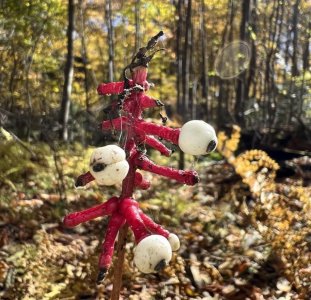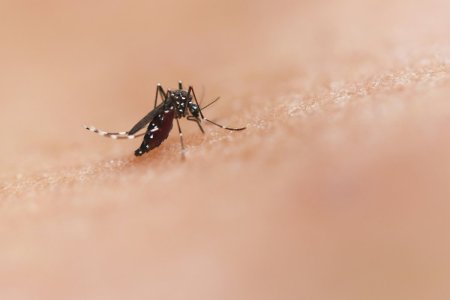Beware: The toxic, creepy plant invading US National Parks—Is it watching you?
By
Aubrey Razon
- Replies 0
In the lush landscapes of America's national parks, a peculiar and potentially dangerous plant is catching the eyes of visitors—and not in a good way.
The National Park Service has issued a warning about a toxic plant spreading its eerie presence across the country. With its ghostly white berries that eerily resemble eyeballs, it's no wonder the plant has both fascinated and alarmed nature enthusiasts.
Learn more about this hazardous flora before you encounter it.
The white baneberry, scientifically known as Actaea pachypoda, belongs to the family Ranunculaceae and is native to the woodlands of North America.
It's a plant that could easily star in a botanical horror story, with its striking fruit that has earned it the nickname “doll's eyes.” These berries are about 1 cm in diameter, with a stark white hue and a contrasting black stigma scar that creates an unsettling optical illusion.
The National Park Service's social media post, complete with a photo of the plant, humorously asked, “Did it just blink?” But the jest underscores a serious message: despite its intriguing appearance, baneberry is not to be trifled with.
While the baneberry's “eyeballs” might be a visual treat for birdwatchers, and the birds themselves can safely feast on these berries, the same cannot be said for humans.
The plant contains toxic compounds that, if ingested, can lead to a host of unpleasant symptoms including nausea, vomiting, stomach cramps, and delirium. In severe cases, and particularly if consumed in large quantities, the toxins can be fatal.
The risk is especially high for children and pets, who might be drawn to the plant's unusual appearance.
The National Park Service's warning is a reminder to all park visitors to admire the baneberry from a distance and resist the urge to touch or taste.
The baneberry has certainly made an impression on social media, with users quick to express their thoughts on the plant's nightmarish appearance. Comments range from humorous takes on the plant's deterrent qualities to expressions of disbelief that anyone would consider it edible.
“This plant just screams ‘Don’t Eat Me!’ Why any human would think such a grotesque thing was palatable is beyond me,” one user said.
One user grimaced at the thought of the berries' “optic nerves,” the reddish stems that connect them, adding to the plant's horror movie aesthetic.
“As if the eyeballs weren’t enough, they all have reddish ‘optic nerves’ attaching them together,” commented said user. “Nightmarish.”
The baneberry serves as a reminder of the importance of respecting nature's boundaries. In a similar story, read how this other dangerous plant can ruin your health.
Remember, the great outdoors is full of surprises, and while some are delightful, others—like the baneberry—deserve a healthy dose of caution. Keep your eyes open, not just for the beauty around you, but also for the hidden dangers lurking beneath the leaves.
 Have you encountered the baneberry or other toxic plants on your nature walks? Do you have tips for safely enjoying the wilderness? Share your stories and advice in the comments below.
Have you encountered the baneberry or other toxic plants on your nature walks? Do you have tips for safely enjoying the wilderness? Share your stories and advice in the comments below.
The National Park Service has issued a warning about a toxic plant spreading its eerie presence across the country. With its ghostly white berries that eerily resemble eyeballs, it's no wonder the plant has both fascinated and alarmed nature enthusiasts.
Learn more about this hazardous flora before you encounter it.
The white baneberry, scientifically known as Actaea pachypoda, belongs to the family Ranunculaceae and is native to the woodlands of North America.
It's a plant that could easily star in a botanical horror story, with its striking fruit that has earned it the nickname “doll's eyes.” These berries are about 1 cm in diameter, with a stark white hue and a contrasting black stigma scar that creates an unsettling optical illusion.
The National Park Service's social media post, complete with a photo of the plant, humorously asked, “Did it just blink?” But the jest underscores a serious message: despite its intriguing appearance, baneberry is not to be trifled with.
While the baneberry's “eyeballs” might be a visual treat for birdwatchers, and the birds themselves can safely feast on these berries, the same cannot be said for humans.
The plant contains toxic compounds that, if ingested, can lead to a host of unpleasant symptoms including nausea, vomiting, stomach cramps, and delirium. In severe cases, and particularly if consumed in large quantities, the toxins can be fatal.
The risk is especially high for children and pets, who might be drawn to the plant's unusual appearance.
The National Park Service's warning is a reminder to all park visitors to admire the baneberry from a distance and resist the urge to touch or taste.
The baneberry has certainly made an impression on social media, with users quick to express their thoughts on the plant's nightmarish appearance. Comments range from humorous takes on the plant's deterrent qualities to expressions of disbelief that anyone would consider it edible.
“This plant just screams ‘Don’t Eat Me!’ Why any human would think such a grotesque thing was palatable is beyond me,” one user said.
One user grimaced at the thought of the berries' “optic nerves,” the reddish stems that connect them, adding to the plant's horror movie aesthetic.
“As if the eyeballs weren’t enough, they all have reddish ‘optic nerves’ attaching them together,” commented said user. “Nightmarish.”
The baneberry serves as a reminder of the importance of respecting nature's boundaries. In a similar story, read how this other dangerous plant can ruin your health.
Remember, the great outdoors is full of surprises, and while some are delightful, others—like the baneberry—deserve a healthy dose of caution. Keep your eyes open, not just for the beauty around you, but also for the hidden dangers lurking beneath the leaves.
Key Takeaways
- Park rangers are warning the public about the poisonous “baneberry” plant, which should not be consumed by humans.
- The National Park Service posted about the plant on social media, noting its white berries that resemble eyeballs and are called “doll's eyes.”
- While the plant's berries are not harmful to birds, they are toxic to humans and can cause symptoms such as nausea, vomiting, and even death if consumed in large amounts.
- Social media users have expressed their aversion to the plant, with comments about its nightmarish appearance and the inherent visual warning not to eat it.







